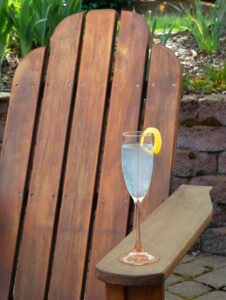I come before you today with a confession: My mixology education contains many gaps.
Which is no surprise. This blog, after all, is subtitled “It only looks like we know what we’re doing,” and often even that’s overly generous.
Besides, I grew up in Idaho. For my parents, the only cocktail was Ancient Age Bourbon with 7UP on the rocks. When I was old enough to consume alcohol, I dove headfirst into frozen Margaritas (I was listening to a lot of Jimmy Buffett at the time.) And I didn’t discover my beloved gin until I was in my 30s.
All of which explains my puzzlement when, while perusing a Serious Eats listicle of “25 Cocktail Recipes Everyone Should Know,” I was completely befuddled by one entry: the French 75.
Never made it. Never had it. Never heard of it.
Admittedly, no bartender except Samuel “Mayday” Malone can possibly know how to make every cocktail ever invented. But this French 75 thing is supposedly a classic. It’s known as the most famous American cocktail invented during Prohibition. It even makes a cameo appearance in Casablanca (it’s the drink Yvonne’s Nazi boyfriend orders for them.). As barfly and boozehound Michael Dietsch puts it, “If you’re a cocktail geek, and you don’t have the French 75 in your repertoire for parties, I’m sorry, but you’re not a cocktail geek.”
Clearly I wasn’t. Until now.
For those who have had a French 75 recently, it was probably prepared with a base spirit of cognac and a splash of sparkling wine, served neat in a champagne flute. But that’s not how the original was made. The earliest mention of a “75” cocktail (“very popular in France during the war, and named after the French light field gun”) came in Harry MacElhone’s Harry’s ABC of Mixing Cocktails in 1919. But that drink consisted of grenadine, absinthe, calvados, and gin, and was served in a cocktail glass.
A more recognizable incarnation appeared in 1930 in the Savoy Cocktail Book by Harry Craddock, with gin, lemon juice, and sugar, topped off with champagne. (Note: All the best bartenders are named Harry. No offense, Mayday.)
The difference between the 1930 version and what’s typically offered up today? Craddock served his in a Collins glass filled with cracked ice instead of a flute with no ice. And since the 1940s, cognac seems to have replaced gin as the base of choice.
How to decide? I have my preference, but in recent years I’ve become rather Unitarian in my approach to cocktail construction–that is, your truth is your own, with respect for all.
So, traditional or modern? Cognac or gin? Glass or flute?
The correct answer, whatever the case, is oui.
French 75 Ma Façon
2 ounces gin
1/2 ounce fresh lemon juice
1/2 teaspoon simple syrup
4 ounces chilled sparkling wine
Lemon twist for garnish
In a mixing glass filled with ice, stir together the first three ingredients. Pour into a champagne flute and add the bubbly. Garnish with a lemon twist.

